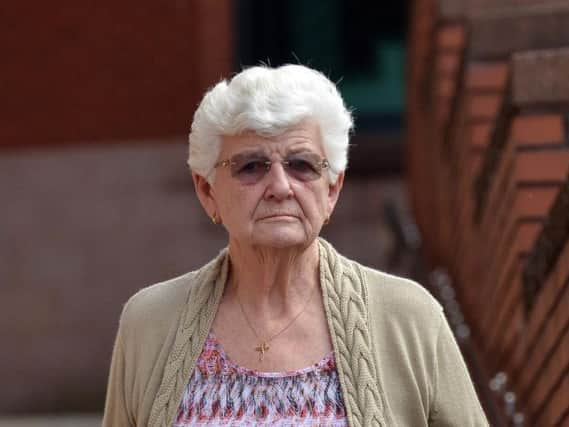OAP who knocked down woman blames car "fault"


Ann Diggles, 82, of Dalehead Avenue, Leyland, denies causing the death of pedestrian Julie Dean by dangerous driving - and an alternative charge of death by careless driving - at Preston Crown Court.
Jurors were told the collision, on July 7, 2014, on Sumner Street in Leyland " had tragic consequences for all involved" when the car mounted the pavement outside the St Catherine's Hospice Charity shop and collided with Mrs Dean, who was leaving the shop.
Advertisement
Hide AdAdvertisement
Hide AdProsecuting, Richard Archer said: "The collision was not at particularly high speed, but Mrs Dean ended up face down on the pavement with Mrs Diggle’s car over the top half of her body. Mrs Dean sustained injuries that proved fatal and she was pronounced dead at the scene.
"One witness, Chelsea McKay described Mrs Diggles’ car as being “out of control” and witnesses saw Mrs Diggles hit a grey Citroen Picasso that was parked on the street outside the tattoo studio before mounting the pavement, becoming wedged between the wall and the parked cars before ultimately colliding with Mrs Dean.
" Mrs Diggles told police at the scene 'I moved to the right and the car just went out of control. I couldn’t stop it. I then saw the lady but I just couldn’t stop it and we got jammed between a car and a wall.'"
The court heard Mrs Diggles parked on the opposite side of the road on double yellow lines, intending to display her disabled badge, when she saw a space become free in a designated parking bay
Advertisement
Hide AdAdvertisement
Hide AdIn her police interview, she said her car "took off" and that she had pressed the brake but "nothing happened".
The court heard collision investigator PC Richard Harrison located tyre marks on the road, which he says are "acceleration marks".
Mr Archer added: "It follows, therefore, as a logical conclusion that this collision occurred because Mrs Diggles pressed the accelerator instead of the brake. Mrs Diggles found the brake unresponsive. The reality was, she hadn’t pressed it, at least not until it was too late.
" The defence on the other hand, say that this incident was caused by a complex electrical scenario known as a sudden acceleration incident. In other words, they say that the electronic transmission of a car malfunctioned because of a combination of factors, possibly including an undercharged battery and demand for power from air conditioning which can and did cause the car to accelerate without any input from Mrs Diggles."
Advertisement
Hide AdAdvertisement
Hide AdIn evidence, an independent electrical engineering expert witness told jurors there is a "million million chance" the pensioner's electrical and braking systems malfunctioned at the same time.
Doctor Robert Brown said modern car systems were designed to suppress electromagnetic interference and glitches, and if errors were detected they would be logged in the car's computer system.
He said: "It isn't infallible, there is a slight possibility that both systems could have failed. Of all the cars on the road there is a million million chance - so it's quite slim.
" I conclude that the only way this circumstance could have happened was Mrs Diggles put her foot on the accelerator rather than the brake."
Mrs Diggles, wearing headphones, watched from the dock as proceedings took place.
(proceeding)